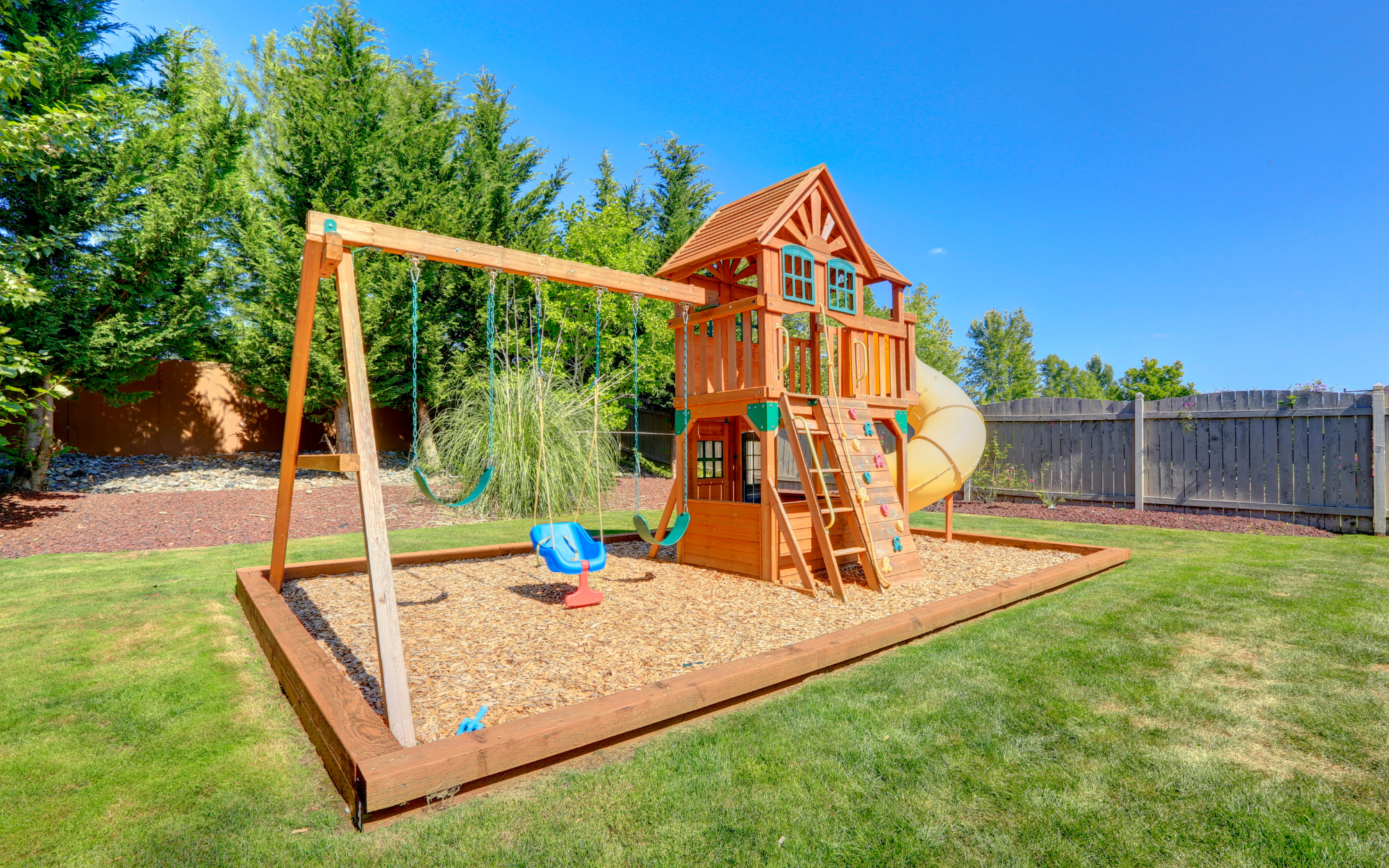Four Ways to Make Your Backyard More Autism Friendly
Playing outdoors has huge implications for all children. Many researchers cite outdoor play as being a conduit for decreased stress levels, emotional resilience, increased cognitive functioning, increased attention, as well as a host of other sensory-motor, emotional, and social benefits3.
Playing outside can also support many developmental advantages such as skill-building, turn-taking, sensory play, balance, coordination, and an overall appreciation of nature4. Moreover, outdoor play encourages language and cooperative skills as well as allowing children opportunities to experience the real world and practice activities that adults may do, such as taking care of a garden.
 For children with autism in particular, outdoor play can take on a similar yet more significant meaning. Many children with autism must maintain a diverse “sensory diet” in order to regulate their senses. Often, in our busy technological world, children may get a sensory overload in one sense, such as vision, leaving the other senses needing more exposure. Thus, in order to create more of a balanced sensory diet for our children with autism, providing opportunities for outdoor play in an autism-friendly backyard can be especially beneficial for maintaining healthy sensory input and brain development5.
For children with autism in particular, outdoor play can take on a similar yet more significant meaning. Many children with autism must maintain a diverse “sensory diet” in order to regulate their senses. Often, in our busy technological world, children may get a sensory overload in one sense, such as vision, leaving the other senses needing more exposure. Thus, in order to create more of a balanced sensory diet for our children with autism, providing opportunities for outdoor play in an autism-friendly backyard can be especially beneficial for maintaining healthy sensory input and brain development5.
With all the many benefits of playing outdoors, there are multiple ways to support inclusive, sensory-friendly, fun, and accessible play right in the comfort of your own backyard. Keep reading for four key ways to make your backyard more autism-friendly.
- Safety first!
Remember, the goal is to have a backyard that is autism-friendly, but also safe. Children with autism have diverse needs, and their autism may manifest in different ways. Some children may take to running more often, while others may be more likely to retreat. Regardless, it would be imperative to install a fence that encloses the backyard so as to prevent injury. Additionally, be sure that hazardous tools are removed from the backyard, such as gardening tools that have been left out on the ground, branches from trees, or unsafe plants.
- Consider the structures you have and adapt them to avoid sensory overload.
When planning for new structures in your backyard, consider providing areas that lessen, but do not completely eliminate noise. This is helpful with regards to developing key coping skills for children with autism. For example, a playhouse can be extremely helpful in the backyard, and can be outfitted with sound-absorbing furniture such as pillows or indoor/outdoor carpeting. When outfitting your structures or incorporating new play structures into your backyard, consider using calming colors so as not to overstimulate your child. Stay away from bright, bold colors, and seek more neutral or cool colors.
- Sensory-friendly play is a must!
Sensory play can be very helpful to direct an overstimulated child to a more calming activity. A few sensory activities you can do with your child include:
 Swinging: Many children with autism benefit greatly from using a swing, as they are likely to find the back and forth motion predictable and calming. Additionally, swinging can improve muscle strength and mood. Swings such as hammock chairs, ball swings, platform swings, or cocoon swings can be especially beneficial for children with autism.
Swinging: Many children with autism benefit greatly from using a swing, as they are likely to find the back and forth motion predictable and calming. Additionally, swinging can improve muscle strength and mood. Swings such as hammock chairs, ball swings, platform swings, or cocoon swings can be especially beneficial for children with autism.- Plant a garden: The backyard can be an awesome place to utilize the environment and learn about a myriad of topics. For example, planting a sensory garden with herbs, vegetables, and fragrance-free flowers can be one way to teach your child about food choices and gardening. Children with autism would benefit from wearing nitrile gloves, feeling the soil and plants, and holding various garden tools, further supporting their need for sensation.
- Utilize a sandbox: Many amazing things happen in a sandbox, and a lot of those things stem from the vivid imagination and creative play that can take shape through sand. Children with autism can benefit deeply from a sandbox as the feeling of sand can support their need for sensation while also supporting their vivid imagination.
- Incorporate water: Water play not only develops fine motor and critical thinking skills, but it can also be a great distraction and great fun! Children with autism will likely enjoy doing activities with lots of water and soap, such as mimicking a car wash with toy cars. They also can benefit from the sensory experiences that can come from creating rainbow bubbles or creating noodle boats.
- Take advantage of key learning experiences and teachable moments.
The backyard can be a hub not just for sensory-friendly play, but also for learning in general. One way to incorporate key learning experiences is by creating a bird feeder for children to get into the habit of feeding and watching birds. Children could learn about the different bird types, the importance of feeding birds daily, further enhancing their responsibility skills and their social cognitive functioning. It also brings in many different senses – sight, touch, hearing – which is beneficial for all children and especially children with autism.
While technology has its benefits, there is still a great deal of success and satisfaction that comes from outdoor play. Children with autism need the exposure to many different environments to further develop their social-emotional skills, support healthy development, and encourage coping skills. The benefits of play to improve attention spans and decrease stress while also advancing social skills is necessary and valuable for our children with autism, especially when combined with opportunities for inclusion with peers. An autism-friendly backyard is one way to encourage play and develop key skills for children with autism and can be a great tool to foster social-emotional skills while also developing an appreciation for nature.
For a resource on Designing the Perfect Home Playroom for Children with Autism, view the article here!
References:
1Dyoco, Jasmine. “Creating a Sensory Friendly Backyard.” The Art of Autism, https://the-art-of autism.com/creating-a-sensory-friendly-backyard/. Accessed 12 November 2019.
2HomeAdvisor. “How to Create a Backyard Sanctuary for Kids with Disabilities.” HomeAdvisor,
https://www.homeadvisor.com/r/disability-friendly-backyard-for-kids/. Accessed 12
November 2019.
3Li, D., Health and Place, https://doi.org/10.1016/j.healthplace.2018.11.005
4“Why Children with Autism Benefit from Outdoor Play.” Marcus Autism Center,
https://www.marcus.org/autism-resources/autism-tips-and-resources/playing-outside.
Accessed 12 November 2019.
5“Why Include Nature in the Sensory Diet of a Child with Autism?”
https://pdf.snapandread.com/viewer.html?url=https%3A%2F%2Fkampn4autism.appstate.edu%2Fsites%2Fkampn4autism.appstate.edu%2Ffiles%2FNATURE-SENSORY%2520DIET%2520BENEFITS.pdf. Accessed 12 November 2019.
6Woods, Rob. “How to Create a Safe Autism-Friendly Backyard.” Middletown Kitchen and Bath,
https://mkbde.com/2018/07/25/how-to-create-a-safe-autism-friendly-backyard/. Accessed
12 November 19.

Madeline Burroughs
Madeline Burroughs is a Specially Designed Instructional Coach at two high schools in Fulton County Schools in Atlanta, GA. In this role, she works to coach special education teachers in providing systematic, specially designed instruction that effectively targets students’ strengths and needs. Madeline received her Master’s degree in Education Policy and Management from Harvard Graduate School of Education in May 2019, and hopes to continue to serve as an advocate for all students with disabilities throughout her career.






